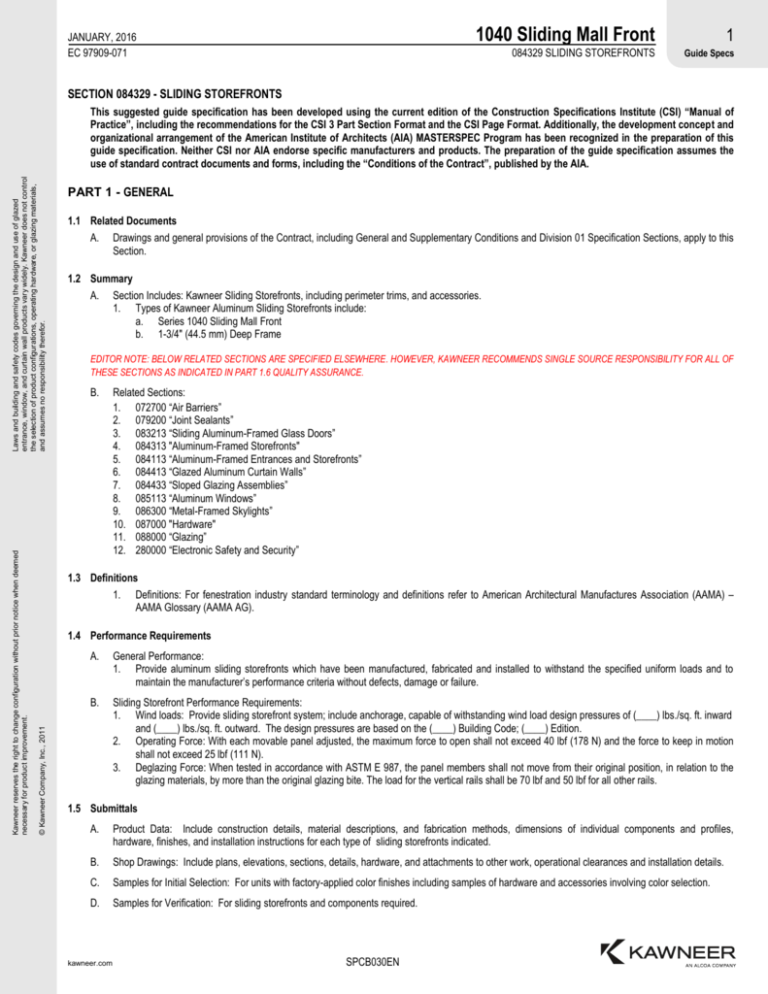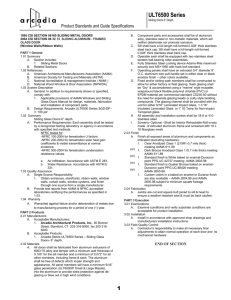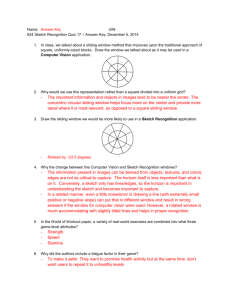editior note: provide information below
advertisement

JANUARY, 2016 EC 97909-071 1040 Sliding Mall Front 1 084329 SLIDING STOREFRONTS Guide Specs SECTION 084329 - SLIDING STOREFRONTS PART 1 - GENERAL 1.1 Related Documents A. Drawings and general provisions of the Contract, including General and Supplementary Conditions and Division 01 Specification Sections, apply to this Section. 1.2 Summary A. Section Includes: Kawneer Sliding Storefronts, including perimeter trims, and accessories. 1. Types of Kawneer Aluminum Sliding Storefronts include: a. Series 1040 Sliding Mall Front b. 1-3/4" (44.5 mm) Deep Frame EDITOR NOTE: BELOW RELATED SECTIONS ARE SPECIFIED ELSEWHERE. HOWEVER, KAWNEER RECOMMENDS SINGLE SOURCE RESPONSIBILITY FOR ALL OF THESE SECTIONS AS INDICATED IN PART 1.6 QUALITY ASSURANCE. B. Related Sections: 1. 072700 “Air Barriers” 2. 079200 “Joint Sealants” 3. 083213 “Sliding Aluminum-Framed Glass Doors” 4. 084313 "Aluminum-Framed Storefronts" 5. 084113 “Aluminum-Framed Entrances and Storefronts” 6. 084413 “Glazed Aluminum Curtain Walls” 7. 084433 “Sloped Glazing Assemblies” 8. 085113 “Aluminum Windows” 9. 086300 “Metal-Framed Skylights” 10. 087000 "Hardware" 11. 088000 “Glazing” 12. 280000 “Electronic Safety and Security” 1.3 Definitions 1. Definitions: For fenestration industry standard terminology and definitions refer to American Architectural Manufactures Association (AAMA) – AAMA Glossary (AAMA AG). 1.4 Performance Requirements © Kawneer Company, Inc., 2011 Kawneer reserves the right to change configuration without prior notice when deemed necessary for product improvement. Laws and building and safety codes governing the design and use of glazed entrance, window, and curtain wall products vary widely. Kawneer does not control the selection of product configurations, operating hardware, or glazing materials, and assumes no responsibility therefor. This suggested guide specification has been developed using the current edition of the Construction Specifications Institute (CSI) “Manual of Practice”, including the recommendations for the CSI 3 Part Section Format and the CSI Page Format. Additionally, the development concept and organizational arrangement of the American Institute of Architects (AIA) MASTERSPEC Program has been recognized in the preparation of this guide specification. Neither CSI nor AIA endorse specific manufacturers and products. The preparation of the guide specification assumes the use of standard contract documents and forms, including the “Conditions of the Contract”, published by the AIA. A. General Performance: 1. Provide aluminum sliding storefronts which have been manufactured, fabricated and installed to withstand the specified uniform loads and to maintain the manufacturer’s performance criteria without defects, damage or failure. B. Sliding Storefront Performance Requirements: 1. Wind loads: Provide sliding storefront system; include anchorage, capable of withstanding wind load design pressures of (____) lbs./sq. ft. inward and (____) lbs./sq. ft. outward. The design pressures are based on the (____) Building Code; (____) Edition. 2. Operating Force: With each movable panel adjusted, the maximum force to open shall not exceed 40 lbf (178 N) and the force to keep in motion shall not exceed 25 lbf (111 N). 3. Deglazing Force: When tested in accordance with ASTM E 987, the panel members shall not move from their original position, in relation to the glazing materials, by more than the original glazing bite. The load for the vertical rails shall be 70 lbf and 50 lbf for all other rails. 1.5 Submittals A. Product Data: Include construction details, material descriptions, and fabrication methods, dimensions of individual components and profiles, hardware, finishes, and installation instructions for each type of sliding storefronts indicated. B. Shop Drawings: Include plans, elevations, sections, details, hardware, and attachments to other work, operational clearances and installation details. C. Samples for Initial Selection: For units with factory-applied color finishes including samples of hardware and accessories involving color selection. D. Samples for Verification: For sliding storefronts and components required. kawneer.com SPCB030EN 1040 Sliding Mall Front Guide Specs 084329 SLIDING STOREFRONTS JANUARY, 2016 EC 97909-071 E. Product Test Reports: Based on evaluation of comprehensive tests performed by a qualified testing agency for each type, class, grade, and size of sliding storefronts. Test results based on use of downsized test units will not be accepted. F. Other Action Submittals: 1. Sliding Storefront Hardware Schedule: Prepared by or under the supervision of supplier, detailing fabrication and assembly of sliding storefront hardware, as well as procedures and diagrams. Coordinate final sliding storefront hardware schedule with doors, frames, and related work to ensure proper size, thickness, hand, function, and finish of sliding storefront hardware. 1.6 Quality Assurance A. Installer Qualifications: An installer which has had successful experience with installation of the same or similar units required for the project and other projects of similar size and scope. B. Manufacturer Qualifications: A manufacturer capable of fabricating sliding storefronts that meet or exceed performance requirements indicated and of documenting this performance by inclusion of test reports, and calculations. C. Source Limitations: Obtain sliding storefront through one source from a single manufacturer. D. Product Options: Drawings indicate size, profiles, and dimensional requirements of sliding storefronts and are based on the specific system indicated. Refer to Division 01 Section “Product Requirements”. Do not modify size and dimensional requirements. 1. Do not modify intended aesthetic effects, as judged solely by Architect, except with Architect's approval. If modifications are proposed, submit comprehensive explanatory data to Architect for review. E. Mockups: Build mockups to verify selections made under sample submittals and to demonstrate aesthetic effects and set quality standards for materials and execution. 1. Build mockup for type(s) of sliding storefront(s) indicated, in location(s) shown on Drawings. F. Pre-installation Conference: Conduct conference at Project site to comply with requirements in Division 01 Section “Project Management and Coordination”. 1.7 Project Conditions A. Field Measurements: Verify actual dimensions of sliding storefront openings by field measurements before fabrication and indicate field measurements on Shop Drawings. Laws and building and safety codes governing the design and use of glazed entrance, window, and curtain wall products vary widely. Kawneer does not control the selection of product configurations, operating hardware, or glazing materials, and assumes no responsibility therefor. 2 2.1 Manufacturers A. Basis-of-Design Product: 1. Kawneer Company Inc. 2. Series 1040 Sliding Mall Front 3. Framing Member Profile: 1-3/4" (44.5) Deep Frame EDITIOR NOTE: PROVIDE INFORMATION BELOW INDICATING APPROVED ALTERNATIVES TO THE BASIS-OF-DESIGN PRODUCT. B. Subject to compliance with requirements, provide a comparable product by the following: 1. Manufacturer: (__________) 2. Series: (__________) 3. Profile dimension: (__________) 4. Performance Grade: (__________) C. Substitutions: Refer to Substitutions Section for procedures and submission requirements. 1. Pre-Contract (Bidding Period) Substitutions: Submit written requests ten (10) days prior to bid date. 2. Post-Contract (Construction Period) Substitutions: Submit written request in order to avoid sliding storefront installation and construction delays. 3. Product Literature and Drawings: Submit product literature and drawings modified to suit specific project requirements and job conditions. 4. Certificates: Submit certificate(s) certifying substitute manufacturer (1) attesting to adherence to specification requirements for sliding storefront system performance criteria, and (2) has been engaged in the design, manufacturer and fabrication of sliding storefront for a period of not less than ten (10) years. (Company Name) 5. Test Reports: Submit test reports verifying compliance with each test requirement required by the project. 6. Samples: Provide samples of typical product sections and finish samples in manufacturer's standard sizes. D. Substitution Acceptance: Acceptance will be in written form, either as an addendum or modification, and documented by a formal change order signed by the Owner and Contractor. SPCB030EN kawneer.com © Kawneer Company, Inc., 2011 PART 2 - PRODUCTS Kawneer reserves the right to change configuration without prior notice when deemed necessary for product improvement. 1.8 Warranty A. Manufacturer’s Warranty: Submit, for Owner’s acceptance, manufacturer’s standard warranty. 1. Warranty Period: Two (2) years from Date of Substantial Completion of the project provided however that the Limited Warranty shall begin in no event later than six months from date of shipment by manufacturer. JANUARY, 2016 EC 97909-071 1040 Sliding Mall Front 3 084329 SLIDING STOREFRONTS Guide Specs Laws and building and safety codes governing the design and use of glazed entrance, window, and curtain wall products vary widely. Kawneer does not control the selection of product configurations, operating hardware, or glazing materials, and assumes no responsibility therefor. 2.2 Materials A. Aluminum Extrusions: Alloy and temper recommended by sliding storefront manufacturer for strength, corrosion resistance, and application of required finish and not less than 0.090" (2.3 mm) wall thickness at any location for the main frame and sash members. B. Fasteners: Aluminum, nonmagnetic stainless steel or other materials to be non-corrosive and compatible with sliding storefront members, trim hardware, anchors, and other components. C. Anchors, Clips, and Accessories: Aluminum, nonmagnetic stainless steel, or zinc-coated steel or iron complying with ASTM B 633 for SC 3 severe service conditions or other suitable zinc coating; provide sufficient strength to withstand design pressure indicated. D. Reinforcing Members: Aluminum, nonmagnetic stainless steel, or nickel/chrome-plated steel complying with ASTM B 456 for Type SC 3 severe service conditions, or zinc-coated steel or iron complying with ASTM B 633 for SC 3 severe service conditions or other suitable zinc coating; provide sufficient strength to withstand design pressure indicated. E. Sliding-Type Weather Stripping: Provide woven-pile weather stripping of wool, polypropylene, or nylon pile and resin-impregnated backing fabric. Comply with AAMA 701/702. 1. Weather Seals: Provide weather stripping with integral barrier fin or fins of semi-rigid, polypropylene sheet or polypropylene-coated material. Comply with AAMA 701/702. 2. Sealant: For sealants required within fabricated sliding storefront, provide sliding storefront manufacturer's standard, permanently elastic, nonshrinking, and non-migrating type recommended by sealant manufacturer for joint size and movement. 2.3 Sliding Storefront A. 1040 Sliding Mall Front Performance Requirements: 1. Single track; parallel staggered, even and perpendicular 90 degree angle. 2.4 Glazing A. Glass and Glazing System: Refer to Division 08 Section “Glazing” for glass units and glazing requirements applicable to glazed sliding storefront units. B. Glass: Comply with Division 08 Section “Glazing” for requirements applicable to safety glazing, insulating-glass units, and laminated glass units. C. Glazing System: Glazing method shall be a channel type PVC gasket (marine glazed) which is compatible with aluminum and shall be resistant to deterioration by all forms of weathering and suitably retained to maintain a watertight seal between the glass and the surrounding frame. B. Standard Hardware: 1. Inboard and Outboard Casters. 2. Inboard and Outboard Head Guides. 3. Adams Rite MS 1850A-505 Hookbolt Lock.. 4. Interior and Exterior Cylinders. 5. Edge Pull. C. Egress Door: 1. Maximum door opening width: (Per Uniform Building Code) 36" (914.4) - 32" (812.8) clear at 90 degrees. 2. Maximum door opening width: 42" (1066.8) (requires sidelight and/or transom for stability). 3. Minimum door opening height: (Per Uniform Building Code) 80" (2032). 4. Maximum door opening height: 90" (2286). 5. Maximum threshold height: (Per uniform Building Code) 1/2" (12.7). 6. Door cannot be hinged off of sidelight. 7. Minimum light opening width of sidelight: 6-1/4" (158.8). 8. Maximum light opening width of sidelight: 18" (457.2). 9. Standard Hardware: a. Walking beam top pivot with modified center bottom pivot. b. Adams Rite M.S. 1850 A lock with two (2) cyclinders. 10. Optional Hardware: a. Thumbturn inside in lieu of cylinder. b. Adams Rite 4510 latchlock with 4656 handle in lieu of A.R.M.S.1850 A. c. Adams Rite 4089 exit indicator. d. Cylinder guard. e. Flush pull in door. 11. Not available: a. Closers. b. Panic Decives. c. Push-pull Hardware. d. Pairs of doors or double sidelighted units. © Kawneer Company, Inc., 2011 Kawneer reserves the right to change configuration without prior notice when deemed necessary for product improvement. 2.5 Hardware A. General: Provide manufacturer's standard hardware fabricated from aluminum, stainless steel, or other corrosion-resistant material compatible with aluminum; designed to smoothly operate, tightly close, and securely lock sliding storefronts. kawneer.com SPCB030EN 4 1040 Sliding Mall Front Guide Specs 084329 SLIDING STOREFRONTS JANUARY, 2016 EC 97909-071 12. Door is not intended for use by general public. 13. Door is to be locked closed before moving panel. 2.7 Fabrication A. General: 1. Fabricate Components per the Manufacturer’s most current Installation Instruction manuals with minimum suggested clearances and shim spacing around the perimeter of the assembly while enabling installation and dynamic movement of the perimeter seal. 2. Accurately fit and secure all joints and corners. Make joints flush, hairline and waterproof. 3. Prepare frames to receive anchor devices as required. 4. When possible, arrange fasteners and attachments to conceal from view. 5. Shop assemble frames to the greatest extent possible and shop seal all horizontal to vertical joints. 2.8 Finishes, General A. Comply with AAMA-AFPA “Anodic Finishes/Painted Aluminum” for recommendations for applying and designating finishes. B. Appearance of Finished Work: Variations in appearance of abutting or adjacent pieces are acceptable if they are within one-half of the range of approved Samples. Noticeable variations in the same piece are not acceptable. Variations in appearance of other components are acceptable if they are within the range of approved samples and are assembled or installed to minimize contrast. 2.9 Aluminum Finishes A. Finish designations prefixed by AA comply with the system established by the Aluminum Association for designating aluminum finishes. B. Factory Finishing: 1. Kawneer Permanodic™ AA-M10C21A44 / AA-M45C22A44, AAMA 611, Architectural Class I Color Anodic Coating (Color __________). 2. Kawneer Permanodic™ AA-M10C21A41 / AA-M45C22A41, AAMA 611, Architectural Class I Clear Anodic Coating (Color #14 Clear) (Optional). 3. Kawneer Permanodic™ AA-M10C21A31, AAMA 611, Architectural Class II Clear Anodic Coating (Color #17 Clear) (Standard). 4. Kawneer Permafluor™ (70% PVDF), AAMA 2605, Fluoropolymer Coating (Color __________). 5. Kawneer Permadize™ (50% PVDF), AAMA 2604, Fluoropolymer Coating (Color __________). 6. Kawneer Permacoat™ AAMA 2604, Powder Coating (Color __________) 7. Other: Manufacturer ____________ Type ____________ Color __________. Laws and building and safety codes governing the design and use of glazed entrance, window, and curtain wall products vary widely. Kawneer does not control the selection of product configurations, operating hardware, or glazing materials, and assumes no responsibility therefor. 2.6 Accessories A. Not available. 3.2 Installation A. Comply with Drawings, Shop Drawings, and manufacturer's written instructions for installing sliding storefronts, hardware, accessories, and other components. B. Install sliding storefronts level, plumb, square, true to line, without distortion or impeding thermal movement, anchored securely in place to structural support, and in proper relation to wall flashing and other adjacent construction. C. Set sill members in bed of sealant or with gaskets, as indicated, for weather tight construction. D. Install sliding storefronts and components to drain condensation, water penetrating joints, and moisture migrating within sliding storefront to the exterior. E. Separate aluminum from dissimilar materials to prevent corrosion or electrolytic action at points of contact. 3.3 Field Quality Control A. Manufacturer's Field Services: Upon Owner’s written request, provide periodic site visit by manufacturer’s field service representative. SPCB030EN kawneer.com © Kawneer Company, Inc., 2011 3.1 Examination A. Examine openings, substrates, structural support, anchorage, and conditions, with Installer present, for compliance with requirements for installation tolerances and other conditions affecting performance of work. Verify rough opening dimensions, levelness of sill plate and operational clearances. Examine wall flashings, vapor retarders, water and weather barriers, and other built-in components to ensure a coordinated, weather tight sliding storefront installation. 1. Masonry Surfaces: Visibly dry and free of excess mortar, sand, and other construction debris. 2. Wood Frame Walls: Dry, clean, sound, well nailed, free of voids, and without offsets at joints. Ensure that nail heads are driven flush with surfaces in opening and within 3 inches (76 mm) of opening. 3. Metal Surfaces: Dry; clean; free of grease, oil, dirt, rust, corrosion, and welding slag; without sharp edges or offsets at joints. 4. Proceed with installation only after unsatisfactory conditions have been corrected. Kawneer reserves the right to change configuration without prior notice when deemed necessary for product improvement. PART 3 - EXECUTION JANUARY, 2016 EC 97909-071 1040 Sliding Mall Front 5 084329 SLIDING STOREFRONTS Guide Specs A. Adjust operating sashes, screens, hardware, and accessories for a tight fit at contact points and weather stripping for smooth operation and weather tight closure. Lubricate hardware and moving parts. B. Clean aluminum surfaces immediately after installing sliding storefronts. Avoid damaging protective coatings and finishes. Remove excess sealants, glazing materials, dirt, and other substances. C. Clean factory-glazed glass immediately after installing sliding storefronts. Comply with glass manufacturer's written recommendations for final cleaning and maintenance. Remove nonpermanent labels, and clean surfaces. D. Remove and replace glass that has been broken, chipped, cracked, abraded, or damaged during construction period. E. Protect sliding storefront surfaces from contact with contaminating substances resulting from construction operations. In addition, monitor sliding storefront surfaces adjacent to and below exterior concrete and masonry surfaces during construction for presence of dirt, scum, mortar, alkaline deposits, stains, or other contaminants. If contaminating substances do contact sliding storefront surfaces, remove contaminants immediately according to manufacturer's written recommendations. DISCLAIMER STATEMENT This guide specification is intended to be used by a qualified construction specifier. The guide specification is not intended to be verbatim as project specification without appropriate modifications for the specific use intended. The guide specification must be used and coordinated with the procedures of each design firm, and the particular requirements of a specific construction project. END OF SECTION 084329 © Kawneer Company, Inc., 2011 Kawneer reserves the right to change configuration without prior notice when deemed necessary for product improvement. Laws and building and safety codes governing the design and use of glazed entrance, window, and curtain wall products vary widely. Kawneer does not control the selection of product configurations, operating hardware, or glazing materials, and assumes no responsibility therefor. 3.4 Adjusting, Cleaning, And Protection kawneer.com SPCB030EN


